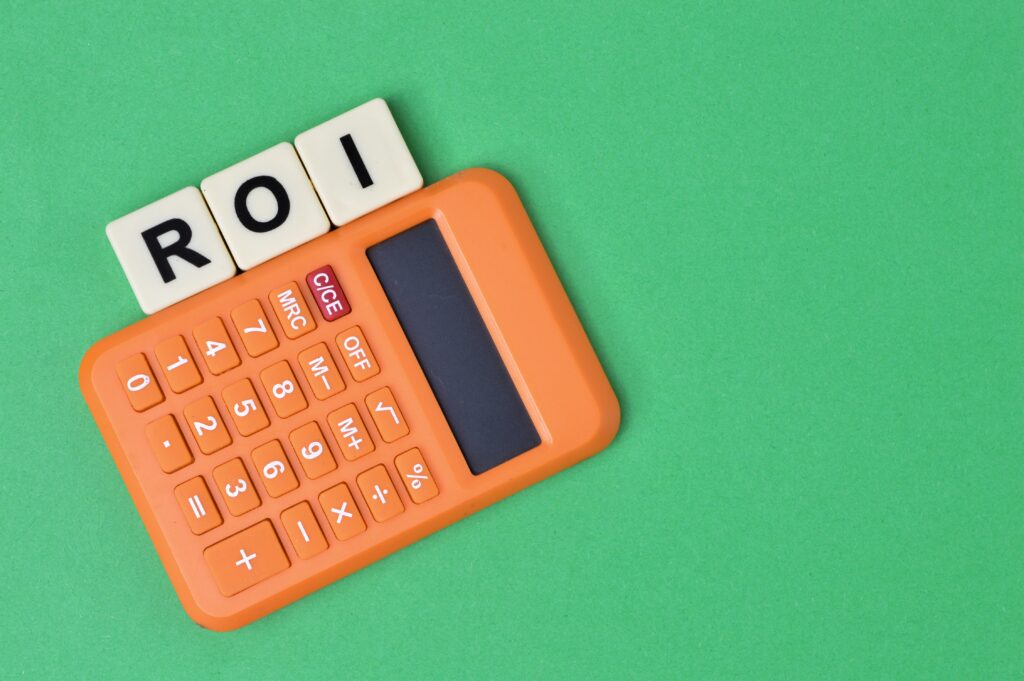As mentioned before, the difficulty when it comes to calculating ROI lies in the consolidation of data and the tracking of complicated financial terms. Using our ROI calculator, businesses can mitigate those pain points and calculate the ROI efficiently and productively.
Here are some of the different approaches that are used to calculate the return on investment.
-
Basic ROI Calculation
As the name suggests, the basic approach involves determining the ROI by taking into consideration the basic cost of investment and the value that the investment generates.
For example, let’s say that you spent $250 to purchase shares in a company. A year later, you sold those shares for $300. In this case, your basic return on investment calculation would be:
Cost of investment = $250
Current value of Investment = $300
ROI = ($300 - $250) / $250 x 100% = 20%
-
Capital Gains ROI Calculation
 Capital gains ROI calculation works on similar lines as the basic approach one. The only difference is that in the capital gains approach, investors must incorporate all the extra benefits that they might have received during the investment window.
Capital gains ROI calculation works on similar lines as the basic approach one. The only difference is that in the capital gains approach, investors must incorporate all the extra benefits that they might have received during the investment window.
For example, let’s say that during the one-year period when you had possession of the purchased shares, the company paid dividends of $12, $34, $15, and $17 in the four quarters respectively.
Therefore, in this case, the calculation for ROI would be:
Cost of investment = $250
Current value of Investment = $300
Extra benefits (total dividends) = $12 + $34 + $15 + $17 = $78
ROI = ($300 + $78 - $250) / $250 x 100% = 51.2%
-
Marketing ROI Calculation
 The tricky part when it comes to calculating marketing ROI is delineating and calculating the various costs associated with all of your marketing efforts.
The tricky part when it comes to calculating marketing ROI is delineating and calculating the various costs associated with all of your marketing efforts.
If you’re one of those wizards who can remember all the different categories and the related costs of the gazillion marketing projects that your agency undertakes, then you’re one of the very few superhumans present on earth who need no help.
However, if you do not belong in that segment and feel that a template that takes care of hours of consolidation and calculation would provide you with value, then this is the tool you need.
Marketing ROI correlates directly with the number of customers that a campaign brings in. For example, let’s assume that your business executed five different strategies — social media marketing, email marketing, outbound marketing, SEO marketing, and inbound marketing — and collectively those strategies led to the acquisition of 200 customers.
Furthermore, let’s assume the breakdown of your marketing spends is as follows:
Social Media = $5,000
Email = $6,000
Outbound = $10,000
SEO = $2,000
Inbound = $8,000
Therefore, the total marketing cost is = 5,000 + 6,000 + 10,000 + 2,000 + 8,000 = $31,000
Now, after calculating your customer LTV you find that value to be $800 and, based on the number of customers you acquired with your marketing campaigns, the total revenue becomes:
Total revenue = 200 x $800 = $160,000
Therefore, your marketing ROI in this case would be:
ROI = ($160,000 - $31,000) / $31,000 x 100% = 416%
-
Customer LTV ROI Calculation
 When it comes to calculating ROI based on the value an individual customer brings to the company, a lot of related factors need to be calculated and taken into consideration as well.
When it comes to calculating ROI based on the value an individual customer brings to the company, a lot of related factors need to be calculated and taken into consideration as well.
For example, in addition to taking the marketing figures mentioned in the previous example, let’s assume that the total sales cost (including salaries and commissions) for your agency is $66,000
Therefore, with the total number of customers acquired being 200, the total customer acquisition cost becomes:
CAC = Total marketing cost + total sales cost / total customers acquired
CAC = $31,000 + $66,000 / 200 = $485
While the rule of thumb suggests that the optimum customer LTV: CAC ratio must be 3:1, when it comes to calculating ROI, there is no right or wrong answer. The desired value for ROI varies from business to business and the goals and targets that they set out to achieve in the beginning.
In this case, the ROI calculation would be:
CAC = $485
Customer LTV = $800
ROI = ($800 - $485) / $485 x 100% = 64.94%
-
Lead Conversion ROI Calculation
 One of the most crucial metrics for measuring ROI is the number of leads a marketing campaign brings in. As logic states, more leads means a better ROI.
One of the most crucial metrics for measuring ROI is the number of leads a marketing campaign brings in. As logic states, more leads means a better ROI.
However, in such scenarios, it becomes imperative that businesses also calculate the ROI from an investment perspective. Bringing in more leads by spending more is good, but for businesses to sustain themselves, they must learn to master the tactics of spending less and generating more.
One way for them to do so is by looking at the total marketing investment and comparing it with the total revenue generated, which can be calculated by knowing the customer LTV.
Looking at our earlier example where we had to choose between email marketing and Facebook ads, let’s assume that both strategies collectively led a total of 6,000 visitors to our business platforms in a specified period.
Based on analyzing the historical data, we’ve also figured out that, on average, approximately 30% of the total visitors on our platform get converted into qualifiable leads. Further, we’ve also deciphered that approximately 11% of those converted leads are closed and brought on board.
As before, using the customer LTV calculator, we were able to find out that the value each customer brings to our business in their lifetime is $800. And finally, keeping track of our campaign spends on email and Facebook, we calculated that the total marketing spends for our business in the specified period is $104,000.
Taking these figures, the calculation for ROI would be:
Total visitors = 6,000
Total clients brought on board = 198
Customer LTV = $800
Total revenue = $158,400
Total marketing investment = $104,000
ROI = ($158,400 - $104,000) / $104,000 x 100% = 52.31%
-
Gross Profit ROI Calculation
 While most software as a service (SaaS) companies calculate their ROI using one of the methods mentioned above, there might be a few who resort to using the gross profit method.
While most software as a service (SaaS) companies calculate their ROI using one of the methods mentioned above, there might be a few who resort to using the gross profit method.
This method involves the analysis of the cost of goods sold (COGS) metric, along with other variable costs that agencies incur. Based on the number of products/units that they sell, businesses can calculate the ROI generated from a project and manage their costs accordingly.
For example, let’s assume that the COGS per unit for a company is approximately $100, the selling price per unit is $200, the number of units sold in a specified period is 500, and the total variable costs amount to $8,000.
Using these values, the calculation for the ROI using the gross profit method would be:
Total COGS = $100 x 500 = $50,000
Total revenue = $200 x 500 = $100,000
Gross profit = ($100,000) - ($50,000 + $8,000) = $42,000
ROI = ($42,000) / ($50,000 + $8,000) x 100% = 72.41%
How to Increase ROI
Once you’ve calculated the ROI and have analyzed the strategies that work well, the next step that businesses must incorporate is to ‘invest’ time and money in ways to increase their ROI.

Businesses must also incorporate other ways to increase ROI. When looking for quick wins, they must analyze and introspect the returns generated from existing investment strategies and plan the way forward.
Maybe Facebook ads are better since they are relatively more accurate when it comes to targeting the right kind of demographic.
Or, maybe email marketing is the way to move forward because it delivers a better ROI when compared to the amount of money invested.
To do so, agencies must implement the 5R philosophy that focuses on targeting the right people by executing the right tactics and strategies by having the right tools and the right teams in place.
Looking at the 5Rs individually and collectively, businesses must come up with the best mix that leads them to increase their revenues, reduce their costs, and ultimately increase their ROI.




